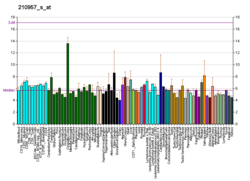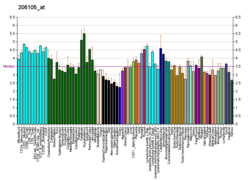AFF2
AF4/FMR2 family member 2 is a protein that in humans is encoded by the AFF2 gene.[3] Mutations in AFF2 are implicated in cases of breast cancer.[4]
References
- 1 2 3 GRCh38: Ensembl release 89: ENSG00000155966 - Ensembl, May 2017
- ↑ "Human PubMed Reference:".
- ↑ "Entrez Gene: AFF2 AF4/FMR2 family, member 2".
- ↑ The Cancer Genome Atlas Network (2012). "Comprehensive molecular portraits of human breast tumours". Nature. Nature Publishing Group. 490 (7418): 61–70. doi:10.1038/nature11412. PMC 3465532. PMID 23000897. Retrieved 24 September 2012.
External links
- Human AFF2 genome location and AFF2 gene details page in the UCSC Genome Browser.
Further reading
- Mulley JC, Yu S, Loesch DZ, et al. (1995). "FRAXE and mental retardation". J. Med. Genet. 32 (3): 162–9. doi:10.1136/jmg.32.3.162. PMC 1050310. PMID 7783162.
- Gecz J, Gedeon AK, Sutherland GR, Mulley JC (1996). "Identification of the gene FMR2, associated with FRAXE mental retardation". Nat. Genet. 13 (1): 105–8. doi:10.1038/ng0596-105. PMID 8673085.
- Gu Y, Shen Y, Gibbs RA, Nelson DL (1996). "Identification of FMR2, a novel gene associated with the FRAXE CCG repeat and CpG island". Nat. Genet. 13 (1): 109–13. doi:10.1038/ng0596-109. PMID 8673086.
- Chakrabarti L, Knight SJ, Flannery AV, Davies KE (1996). "A candidate gene for mild mental handicap at the FRAXE fragile site". Hum. Mol. Genet. 5 (2): 275–82. doi:10.1093/hmg/5.2.275. PMID 8824884.
- Gécz J, Oostra BA, Hockey A, et al. (1997). "FMR2 expression in families with FRAXE mental retardation". Hum. Mol. Genet. 6 (3): 435–41. doi:10.1093/hmg/6.3.435. PMID 9147647.
- Gecz J, Bielby S, Sutherland GR, Mulley JC (1997). "Gene structure and subcellular localization of FMR2, a member of a new family of putative transcription activators". Genomics. 44 (2): 201–13. doi:10.1006/geno.1997.4867. PMID 9299237.
- Chakrabarti L, Bristulf J, Foss GS, Davies KE (1998). "Expression of the murine homologue of FMR2 in mouse brain and during development". Hum. Mol. Genet. 7 (3): 441–8. doi:10.1093/hmg/7.3.441. PMID 9467002.
- Gecz J, Mulley JC (1999). "Characterisation and expression of a large, 13.7 kb FMR2 isoform". Eur. J. Hum. Genet. 7 (2): 157–62. doi:10.1038/sj.ejhg.5200279. PMID 10196698.
- Murray A, Webb J, Dennis N, et al. (1999). "Microdeletions in FMR2 may be a significant cause of premature ovarian failure". J. Med. Genet. 36 (10): 767–70. doi:10.1136/jmg.36.10.767. PMC 1734234. PMID 10528856.
- Dias Neto E, Correa RG, Verjovski-Almeida S, et al. (2000). "Shotgun sequencing of the human transcriptome with ORF expressed sequence tags". Proc. Natl. Acad. Sci. U.S.A. 97 (7): 3491–6. doi:10.1073/pnas.97.7.3491. PMC 16267. PMID 10737800.
- Lo Nigro C, Faravelli F, Cavani S, et al. (2000). "FRAXE mutation in a mentally retarded subject and in his phenotypically normal twin brother". Eur. J. Hum. Genet. 8 (3): 157–62. doi:10.1038/sj.ejhg.5200425. PMID 10780779.
- Tzeng CC, Tzeng PY, Sun HS, et al. (2000). "Implication of screening for FMR1 and FMR2 gene mutation in individuals with nonspecific mental retardation in Taiwan". Diagn. Mol. Pathol. 9 (2): 75–80. doi:10.1097/00019606-200006000-00002. PMID 10850542.
- Musumeci SA, Scuderi C, Ferri R, et al. (2000). "Does a peculiar EEG pattern exist also for FRAXE mental retardation?". Clinical Neurophysiology. 111 (9): 1632–6. doi:10.1016/S1388-2457(00)00367-9. PMID 10964075.
- Hillman MA, Gecz J (2001). "Fragile XE-associated familial mental retardation protein 2 (FMR2) acts as a potent transcription activator". J. Hum. Genet. 46 (5): 251–9. doi:10.1007/s100380170074. PMID 11355014.
- Strausberg RL, Feingold EA, Grouse LH, et al. (2003). "Generation and initial analysis of more than 15,000 full-length human and mouse cDNA sequences". Proc. Natl. Acad. Sci. U.S.A. 99 (26): 16899–903. doi:10.1073/pnas.242603899. PMC 139241. PMID 12477932.
- Kitano T, Schwarz C, Nickel B, Pääbo S (2004). "Gene diversity patterns at 10 X-chromosomal loci in humans and chimpanzees". Mol. Biol. Evol. 20 (8): 1281–9. doi:10.1093/molbev/msg134. PMID 12777533.
- Ross MT, Grafham DV, Coffey AJ, et al. (2005). "The DNA sequence of the human X chromosome". Nature. 434 (7031): 325–37. doi:10.1038/nature03440. PMC 2665286. PMID 15772651.
- Brylawski BP, Chastain PD, Cohen SM, et al. (2007). "Mapping of an origin of DNA replication in the promoter of fragile X gene FMR1". Exp. Mol. Pathol. 82 (2): 190–6. doi:10.1016/j.yexmp.2006.10.004. PMC 1934615. PMID 17196195.
This article is issued from
Wikipedia.
The text is licensed under Creative Commons - Attribution - Sharealike.
Additional terms may apply for the media files.




